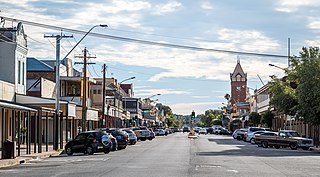
Broken Hill is a city in the far west region of outback New South Wales, Australia. An inland mining city, it is near the border with South Australia on the crossing of the Barrier Highway (A32) and the Silver City Highway (B79), in the Barrier Range. It is 315 m (1,033 ft) above sea level, with a cold semi-arid climate, and an average rainfall of 265 mm (10.4 in). The closest major city is Mildura, 300 km (190 mi) to the south and the nearest State Capital City is Adelaide, the capital of South Australia, which is more than 500 km (310 mi) to the southwest and linked via route A32, the Barrier Highway.

Silverton is a small village at the far west of New South Wales, Australia, 26 kilometres (16 mi) north-west of Broken Hill. At the 2016 census, Silverton had a population of 50.

The Australian state of New South Wales has an extensive network of railways, which were integral to the growth and development of the state. The vast majority of railway lines were government built and operated, but there were also several private railways, some of which operate to this day.
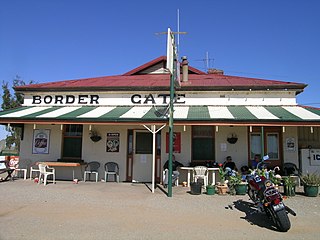
Cockburn is a town and locality in the east of the Australian state of South Australia immediately adjacent to the border with New South Wales near Broken Hill. It was established because the New South Wales government refused to allow locomotives of the South Australian Railways to operate in its jurisdiction, requiring locomotives to be changed at the town for 84 years until 1970, when the route was converted from 1067 mm to 1435 mm standard gauge.

Southern & Silverton Rail was an Australian rail operator founded in 1886 as the Silverton Tramway Company. The company operated the 1067 mm Silverton Tramway, conveying silver-lead-zinc concentrates 58 kilometres from Broken Hill to the South Australian border. In 1970, its main line was bypassed by the newly standardised, government-funded line from Broken Hill to Port Pirie. It then diversified to operating hook-and-pull services and in the mid-1990s rebranded to Silverton Rail. In 2006, it was purchased by South Spur Rail Services and rebranded again as Southern & Silverton Rail, before both entities were sold to Coote Industrial. In June 2010 it was sold to Qube Logistics and absorbed into that brand.

The AFL Broken Hill is an Australian rules football competition based in the Broken Hill region of New South Wales, Australia which has been running since 1890, and since 1900 with the current four clubs. It is the oldest Australian Football League in the state.

Yerranderie is a ghost town located near Kanangra-Boyd National Park of New South Wales, Australia in Wollondilly Shire.

Charles Rasp, born Hieronymous Salvator Lopez von Pereira, is known as the first person to identify the economic potential of the ore deposits at Broken Hill, New South Wales, Australia.

The City of Broken Hill is a local government area in the Far West region of New South Wales, Australia. The area contains an isolated mining city, Broken Hill, located in the outback of New South Wales and is surrounded by the Unincorporated Far West Region. The city is located adjacent to the Silver City and Barrier Highways and the Broken Hill railway line.

The 45 class are a class of diesel-electric locomotives built by AE Goodwin, Auburn for the New South Wales Department of Railways between 1962 and 1964.
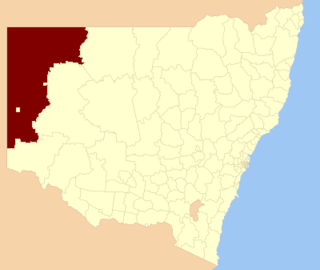
The Unincorporated Far West Area is an unincorporated area in the Far West region of New South Wales, Australia. The area is one of only two areas in New South Wales that are not part of any local government area. The region includes several small towns including Tibooburra, Milparinka and Silverton. Silverton and Tibooburra have village councils. The region includes some parts of Broken Hill, but not the city centre, which is in the separate City of Broken Hill local government area. The current administrator is Mr John McManus. It is the only local government area in Australia to have two time zones.
Wentworth was an electoral district for the Legislative Assembly in the far south west of the Australian state of New South Wales and named after and including the town of Wentworth. It established in 1880 and partly replacing Lachlan. From 1885 until 1889 it elected two members. The population in Wentworth had grown significantly since the 1880 redistribution, especially as a result of the growth of mining at Broken Hill, with the electoral roll growing from 1,901 in 1880 to 5,617 in 1887. Under the formula for seats, Wentworth was due to return 3 members, however because of the large area covered by the district, in 1889 it was split into 3, Wentworth, Sturt and Wilcannia. Wentworth retained the eponymous town, along with the towns of Menindie and Pooncaira. Sturt contained the mining boom towns of Broken Hill, Silverton and Milparinka while Wilcannia was the only town in that district.

The Silverton Tramway was a 58-kilometre-long 1,067 mm railway line running from Cockburn on the South Australian state border to Broken Hill in New South Wales. Operating between 1888 and 1970, it served the mines in Broken Hill, and formed the link between the 1,435 mmstandard gauge New South Wales Government Railways and the narrow gauge South Australian Railways lines. It was owned and operated by the Silverton Tramway Company (STC).
The Silverton Tramway 48s class are a class of diesel locomotives built by AE Goodwin, Auburn for the Silverton Tramway in 1960–1961. The State Rail Authority 48 class and South Australian Railways 830 class are of a very similar design.

Day Dream Smelter is a heritage-listed former smelter and now archaeological site located on an unnamed road at Broken Hill, New South Wales, Australia, approximately 20 km north-west of Broken Hill town. The property is owned by the Broken Hill City Council. It was added to the New South Wales State Heritage Register on 2 April 1999.
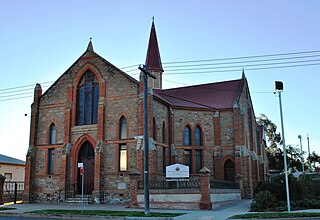
Wesley Uniting Church is a heritage-listed Uniting church at Cobalt Street, Broken Hill, City of Broken Hill, New South Wales, Australia. It was designed by Frederick William Dancker and built from 1885 to 1888 by Messrs. Walter and Morris. It is also known as Wesley Uniting Church and Hall Group, Wesleyan Uniting Church Group, Wesley Church and Wesley Hall. The property is owned by the Uniting Church in Australia. It was added to the New South Wales State Heritage Register on 23 April 2010 and on the Australian Register of the National Estate.

Thackaringa is a rural locality, civil parish, railway stop and cattle station in Far Western New South Wales.
Wallarunga is a rural locality and ghost town located at −32.031799316 and 141.317901611 about 10 kilometres south west of Broken Hill, New South Wales.
Uriah Dudley FIAME was a mining engineer, inventor and mine manager in Broken Hill, New South Wales and in Western Australia. He was secretary, Mine Managers Association of Broken Hill from 1890 and general secretary of the Australasian Institute of Mining and Metallurgy from its foundation in 1893 to 1897.
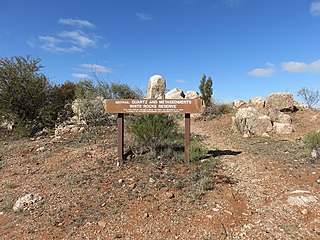
1915 Picnic Train Attack and White Rocks Reserve is a heritage-listed former tramway and now visitor attraction at Hynes Street, Broken Hill, City of Broken Hill, New South Wales, Australia. It was the site of the only attack during World War I that occurred on Australian soil. The property is owned by NSW Department of Industry - Lands and Silverlea Services. It was added to the New South Wales State Heritage Register on 29 June 2018.

















